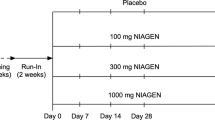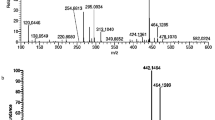Abstract
THE recognition of trigonelline as a product of the metabolism of nicotinic acid is due to Ackermann1, who in 1912 dosed dogs with nicotinic acid and found it to be partly excreted as trigonelline. Linneweh and Reinwein2,3 isolated the latter substance from normal human urine, and found that the amount excreted was increased after the consumption of coffee. More recently Sarett, Perlzweig and Levy4 reported that when human subjects were dosed with nicotinic acid, a portion of it, ranging from 10 to 15 per cent, was excreted as trigonelline. Melnick, Robinson and Field5 have made similar observations. However, the exact relation between the excretion of trigonelline and intake of nicotinic acid remains to be investigated, and can only be settled after a satisfactory quantitative procedure for the estimation of trigonelline has been devised. The methods used by Sarett and his co–workers and by Melnick et al., involve the conversion of trigonelline to nicotinic acid in the presence of strong alkali and ammonia. The conversion according to the former group of workers is 65–75 per cent, and according to the latter group 28–38 per cent. The amount converted seems to depend on the concentration of ammonium salts, the strength of alkali used, the length of hydrolysis, and possibly other factors, and the method at best is only semi–quantitative.
This is a preview of subscription content, access via your institution
Access options
Subscribe to this journal
Receive 51 print issues and online access
$199.00 per year
only $3.90 per issue
Buy this article
- Purchase on Springer Link
- Instant access to full article PDF
Prices may be subject to local taxes which are calculated during checkout
Similar content being viewed by others
References
Ackermann, Z. Biol., 59, 17 (1912).
Linneweh and Reinwein, Z. physiol. Chem., 207, 48 (1932).
Linneweh and Reinwein, ibid., 209, 110 (1938).
Sarett, Perlzweig and Levy, J. Biol. Chem., 135, 483 (1940).
Melnick, Robinson and Field, ibid., 136, 131, 145 (1940).
Harris, Kodicek and Wang, in the Press.
Harris and Raymond, Biochem. J., 33, 2037 (1939).
Melnick and Field, J. Biol. Chem., 134, 1 (1940).
Melnick and Field, ibid., 135, 53 (1940).
Swaminathan, Ind. J. Med. Res., 27, 417 (1939).
Author information
Authors and Affiliations
Rights and permissions
About this article
Cite this article
KODICEK, E., WANG, Y. A New Method for the Estimation of Trigonelline in Urine and Foodstuffs. Nature 148, 23–24 (1941). https://doi.org/10.1038/148023a0
Issue Date:
DOI: https://doi.org/10.1038/148023a0
This article is cited by
Comments
By submitting a comment you agree to abide by our Terms and Community Guidelines. If you find something abusive or that does not comply with our terms or guidelines please flag it as inappropriate.



